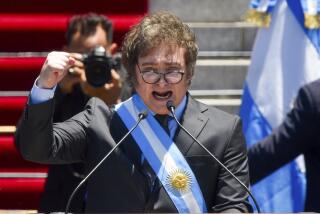$100-Billion Tax Plan Based on Compulsory Savings : Brazil Middle Class to Fund Aid to Poor
- Share via
RIO DE JANEIRO — President Jose Sarney has imposed a compulsory savings plan on middle-class consumers to pay for a $100-billion plan, much like the late Lyndon B. Johnson’s “Great Society,” that includes ambitious social welfare programs for the poor.
“We are constructing the future of Brazil,” said Sarney as he announced the program in a nationally televised speech Wednesday night. “We are going to eradicate the misery that afflicts one-fifth of our population.”
He unveiled his “Plan of National Goals” just four months before major national elections in November. These elections, for members of the National Congress and governors in all states, are critical for Sarney’s centrist political coalition, which faces challenges from both the extreme left and the political right.
Creating New Currency
The government has presented the compulsory loan plan as the growth strategy that complements the anti-inflation program launched Feb. 28. The earlier plan froze prices and wages and created a new currency, the cruzado.
The anti-inflation program won enthusiastic popular support. Armed with price control lists, housewives became “Sarney’s vigilantes,” making sure that supermarkets observed price ceilings. Merchants who ignored the law were arrested and fined.
The plan has been in effect nearly six months and has brought inflation under control. Prices in January and February rose at the rate of 15% a month. In the last five months, the monthly rate has been less than 1%.
The narrow escape from runaway inflation strengthened popular support for Brazil’s democratically elected government. But middle-class reaction to the compulsory loan plan is still unclear, and business reaction has been mixed.
From Private Sector
“This program, which we support in its objective, transfers resources from the private sector to the government. This penalizes the most productive sector of the economy and reinforces a state capitalism which we oppose,” said a statement by the National Assn. of Chambers of Commerce.
The debate over the role of the private and public sectors in economic development has been a constant element in Brazil’s recent political life.
But in this country of 135 million people, where there are wide differences in income, a government that seeks only stabilization is not assured of retaining popularity.
The problem facing Sarney and his economic team, led by Finance Minister Dilson Funaro and Planning Minister Joao Sayad, has been how to raise the money to pay for both economic investment and social improvement that the private sector will not carry out on its own.
No Borrowing Abroad
With a foreign debt of more than $100 billion, Brazil cannot borrow abroad. In New York on Friday, the country signed an agreement with its creditor banks for $31 billion in loan extensions for 1985 and this year.
But this agreement does not provide any new money, and Brazil is still paying about $9 billion annually in interest on the foreign debt. The alternative to increased borrowing is either new foreign investment or raising money at home. Brazil’s $250-billion economy has the resources if they can be mobilized.
The Brazilian economy has been booming since last year, when the gross national product rose 8%. Since the stabilization plan froze prices, consumers have poured billions of dollars in personal savings into consumer goods.
But the government does not have enough resources from taxes and borrowing to fulfill Sarney’s campaign promises to relieve the poverty of millions of peasants and urban slum dwellers.
Forced to Save
The solution adopted this week has been to force wealthier consumers to save and make the savings available to the government.
Under the three-year compulsory loan system, a 28% surcharge will be imposed on gasoline and alcohol fuel sales. New automobile sales will carry a 30% surcharge. Brazilian tourists will have to pay 25% more for airline tickets.
These “loans” are supposed to be repaid in three years with interest of 6% a year. In the meantime, the money will finance a series of major investments and social programs.
The government’s economists also expect the transfer of funds from consumers to the government to dampen demand for consumer goods. Demand for automobiles has been so strong that there is a waiting period of up to three months for delivery of popular models. There are shortages of beef, chicken and pork.
7%-a-Year Growth
Sarney said the new revenue measures would not halt economic growth. The plan calls for maintaining a 7%-a-year growth rate while holding down inflation.
But he said this growth would be shared more equitably. Half of the $100 billion to be invested by 1989 would go into programs to reduce illiteracy, improve nutrition for 15 million children and expectant mothers, create 1.65 million new jobs each year and raise food production by 40%.
Sarney said the new funds would also make it possible to carry on the government’s controversial agrarian reform program. He said 1.4 million peasant families would be settled on their own land by 1989.
These are promises that Sarney has made several times since he took office in March of last year, after a 20-year period of military government in Brazil. But this is the first time he has shown how he hopes to pay for investments that exceed previous estimates of tax revenues.
More to Read
Sign up for Essential California
The most important California stories and recommendations in your inbox every morning.
You may occasionally receive promotional content from the Los Angeles Times.













